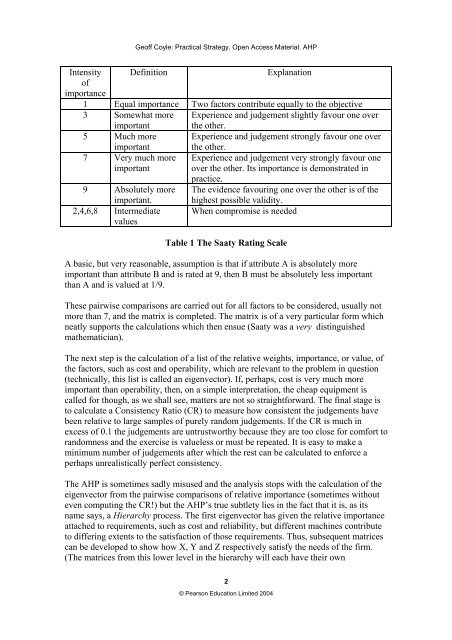THE ANALYTIC HIERARCHY PROCESS (AHP)
THE ANALYTIC HIERARCHY PROCESS (AHP)
THE ANALYTIC HIERARCHY PROCESS (AHP)
Create successful ePaper yourself
Turn your PDF publications into a flip-book with our unique Google optimized e-Paper software.
Geoff Coyle: Practical Strategy. Open Access Material. <strong>AHP</strong><br />
Intensity<br />
of<br />
importance<br />
Definition Explanation<br />
1 Equal importance Two factors contribute equally to the objective<br />
3 Somewhat more Experience and judgement slightly favour one over<br />
important the other.<br />
5 Much more Experience and judgement strongly favour one over<br />
important<br />
7 Very much more<br />
important<br />
9 Absolutely more<br />
important.<br />
2,4,6,8 Intermediate<br />
values<br />
the other.<br />
Experience and judgement very strongly favour one<br />
over the other. Its importance is demonstrated in<br />
practice.<br />
The evidence favouring one over the other is of the<br />
highest possible validity.<br />
When compromise is needed<br />
Table 1 The Saaty Rating Scale<br />
A basic, but very reasonable, assumption is that if attribute A is absolutely more<br />
important than attribute B and is rated at 9, then B must be absolutely less important<br />
than A and is valued at 1/9.<br />
These pairwise comparisons are carried out for all factors to be considered, usually not<br />
more than 7, and the matrix is completed. The matrix is of a very particular form which<br />
neatly supports the calculations which then ensue (Saaty was a very distinguished<br />
mathematician).<br />
The next step is the calculation of a list of the relative weights, importance, or value, of<br />
the factors, such as cost and operability, which are relevant to the problem in question<br />
(technically, this list is called an eigenvector). If, perhaps, cost is very much more<br />
important than operability, then, on a simple interpretation, the cheap equipment is<br />
called for though, as we shall see, matters are not so straightforward. The final stage is<br />
to calculate a Consistency Ratio (CR) to measure how consistent the judgements have<br />
been relative to large samples of purely random judgements. If the CR is much in<br />
excess of 0.1 the judgements are untrustworthy because they are too close for comfort to<br />
randomness and the exercise is valueless or must be repeated. It is easy to make a<br />
minimum number of judgements after which the rest can be calculated to enforce a<br />
perhaps unrealistically perfect consistency.<br />
The <strong>AHP</strong> is sometimes sadly misused and the analysis stops with the calculation of the<br />
eigenvector from the pairwise comparisons of relative importance (sometimes without<br />
even computing the CR!) but the <strong>AHP</strong>’s true subtlety lies in the fact that it is, as its<br />
name says, a Hierarchy process. The first eigenvector has given the relative importance<br />
attached to requirements, such as cost and reliability, but different machines contribute<br />
to differing extents to the satisfaction of those requirements. Thus, subsequent matrices<br />
can be developed to show how X, Y and Z respectively satisfy the needs of the firm.<br />
(The matrices from this lower level in the hierarchy will each have their own<br />
2<br />
© Pearson Education Limited 2004


